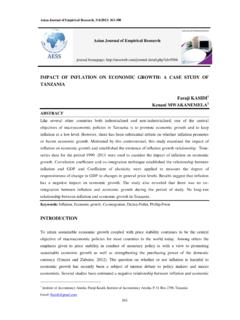Transcription of ADB Economics Working Paper Series
1 ADB Economics Working Paper SeriesHuman Capital DevelopmentHyun H. SonNo. 225 | October 2010 ADB Economics Working Paper Series No. 225 Human Capital DevelopmentHyun H. Son October 2010 Hyun H. Son is Senior Economist in the Office of the Chief Economist, Economics and Research Department, Asian Development Bank. The author acknowledges the insightful comments and suggestions from Michael Alba and Niny Khor in the Asian Development Outlook 2010 workshop, which helped improve an earlier draft of the Paper . The findings, views, and conclusions expressed in this Paper do not necessarily represent the views or policies of the Asian Development Bank or those of the Executive Directors of the Asian Development Bank or the governments they represent.
2 Asian Development Bank6 ADB Avenue, Mandaluyong City1550 Metro Manila, 2010 by Asian Development BankOctober 2010 ISSN 1655-5252 Publication Stock No. WPS102602 The views expressed in this paperare those of the author(s) and do notnecessarily reflect the views or policiesof the Asian Development ADB Economics Working Paper Series is a forum for stimulating discussion and eliciting feedback on ongoing and recently completed research and policy studies undertaken by the Asian Development Bank (ADB) staff, consultants, or resource persons. The Series deals with key economic and development problems, particularly those facing the Asia and Pacific region; as well as conceptual, analytical, or methodological issues relating to project/program economic analysis, and statistical data and measurement.
3 The Series aims to enhance the knowledge on Asia s development and policy challenges; strengthen analytical rigor and quality of ADB s country partnership strategies, and its subregional and country operations; and improve the quality and availability of statistical data and development indicators for monitoring development effectiveness. The ADB Economics Working Paper Series is a quick-disseminating, informal publication whose titles could subsequently be revised for publication as articles in professional journals or chapters in books. The Series is maintained by the Economics and Research vI. Introduction 1II. What is Human Capital? 2 III. The Stock of Human Capital in the World 3IV. Can Developing Countries Catch Up with Industrialized Countries in Increasing Human Capital?
4 6V. Human Capital and economic Growth 10VI. Social and Private Returns to Education 15 VII. Human Capital and the Labor Market 18 VIII. Education policy : Basic Skills versus Highly Skilled Labor 19IX. Summary and policy Recommendations 20 Appendix: Growth Accounting Methodology 23 References 25 AbstractThis Paper has two main objectives. First, it assesses and measures the gaps in the stock of human capital across the world. It presents how effectively different regions are improving their stock of human capital, and how long it will take for developing countries to catch up with the current level of human capital in industrialized countries. Second, it revisits the contribution of human capital to economic growth, proposing a decomposition method to account for employment growth which is also impacted on by human capital growth in explaining growth in total output per worker.
5 The proposed methodology introduces employment growth in the growth decomposition through the employment growth elasticity. It is conjectured that as human capital increases, employment growth elasticity will decrease, making the economy less labor-intensive, resulting in higher economic growth. The proposed method points to the importance of the micro linkage between human capital and the labor IntroductionAccording to modern growth theory, the accumulation of human capital is an important contributor to economic growth. Numerous cross-country studies extensively explore whether educational attainment can contribute significantly to the production of overall output in an economy. Although macro studies have produced inconsistent and controversial results (Pritchett 1996), several micro studies that look into the same problem have shown a consistently positive relationship between the education of the workforce and their labor productivity and earnings (Trostel, Walker, and Woolley 2002; Psacharopoulos and Patrinos 2004a).
6 The general finding is that individuals with more education tend to have better employment opportunities, greater earnings, and produce more output than those who are less educated. These findings provide a strong rationale for governments and households to invest substantial portions of their resources in education, with the expectation that higher benefits will accrue over time. In this context, education is deemed an investment, equipping individuals with knowledge and skills that improve their employability and productive capacities, thereby leading to higher earnings in the future. This study has two main objectives. The first is to measure the gaps in human capital attainment across the world. The second is to explore the issues on how human capital affects labor productivity and earnings for the workforce.
7 The Paper is organized as follows. Section II discusses issues surrounding the definition and measurement of human capital. Section III measures the current level of human capital accumulation across the world. Section IV discusses how effectively different regions are improving their stock of human capital and how long it will take for developing countries to catch up with the current level of human capital in industrialized countries. Section V touches upon the role of human capital in determining economic growth. Sections VI and VII tackle the microeconomic aspects of human capital, with Section VI discussing micro-level empirical findings on returns to education, and Section VII dealing with the issue of labor market mismatch. Section VIII discusses the education policy debate between education for all versus education for highly skilled elite students, and Section IX concludes with some policy recommendations emerging from the findings of the What is Human Capital?
8 Human capital plays a critical role in economic growth and poverty reduction. From a macroeconomic perspective, the accumulation of human capital improves labor productivity; facilitates technological innovations; increases returns to capital; and makes growth more sustainable, which, in turn, supports poverty reduction. Thus, human capital is regarded at the macro level as a key factor of production in the economywide production function. From a microeconomic perspective, education increases the probability of being employed in the labor market and improves earnings capacity. Thus, at the micro level, human capital is considered the component of education that contributes to an individual s labor productivity and earnings while being an important component of firm production.
9 In other words, human capital refers to the ability and efficiency of people to transform raw materials and capital into goods and services, and the consensus is that these skills can be learned through the educational system. That said, human capital development is important for development for its intrinsic value as a development goal in its own right, not only because of its instrumental value. Although the conceptual definition of human capital is clear, its measurement is difficult because it is practically impossible to observe individual skill, and even harder to design a metric that is comparable across individuals and countries. Thus, various proxy measures of human capital have been proposed in the empirical literature, such as literacy rates (Azariadis and Drazen 1990); school enrollment rates (Barro 1991, Mankiw et al.)
10 1992); years of schooling (Barro and Lee 1996, 2001, and 2010; Cohen and Soto 2007); and test scores (Hanushek and Kimko 2000, Hanushek and Woessmann 2009). While the literacy rate, which measures the proportion of the population who can read and write, is an important measure of well-being, it does not measure the educational attainment or skill level of the workforce. On the other hand, school enrollment rate is a relevant metric only for school-age children and has little relevance for the workforce. Although years of schooling can reasonably capture the human capital stock of the workforce, this only reflects the quantity of human capital; it does not give an indication of the skill level of the workforce. This brings us to test scores, an indicator of human capital suggested by Hanushek and Kimko (2000), which reflects the quality of education and is closely related to individual skill.



















